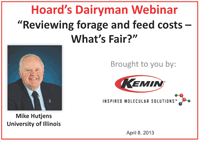 Few things can irritate a person like finding out they overpaid for a product or did not sell their own for its true value. In the April 8 Hoard's Dairyman "Reviewing forage and feed costs – What's fair?" webinar, Mike Hutjens, University of Illinois, stressed the importance of learning the true costs of feed production so you can best manage your resources.
Few things can irritate a person like finding out they overpaid for a product or did not sell their own for its true value. In the April 8 Hoard's Dairyman "Reviewing forage and feed costs – What's fair?" webinar, Mike Hutjens, University of Illinois, stressed the importance of learning the true costs of feed production so you can best manage your resources.If you are a dairy producer and grow your own feed, how is your business enterprise calculating that expense? Do you account for land, machinery use, fertilizers, labor and transportation costs when you consider the price of the grain, silage or hay you feed to your cows? If not, there is no better time than now to really break down your costs.
There are many ways to price feed for sale or purchase. The raw cost of producing it on farm, the going rate for a similar product in the region, basing the expense on the nutritional value of the feed or the price value of the feed at the time of sale. Depending on when you purchase the feed, the market price could vary if you purchase at one time of the year and feed it at another.
On the dairy cow side, there are several formulas that get used to determine profit levels, such as feed costs per cow per day, cost to produce 100 pounds of milk per day, feed costs per pound of dry matter consumed, income over feed costs and feed efficiency. Knowing these formulas and how your individual operation fares, can help you make economic decisions of whether to sell a crop or feed it to your cows.
The Hoard's Dairyman Farm was used as a case study in the webinar. It owns and rents land for alfalfa, corn and wheat and uses custom operators for all field work. The costs of production, for both owned and rented land, need to be established to determine if they are appropriately aligned. For its alfalfa crop, the farm spreads its seeding costs over the expected lifespan of the stand, using three years as a base. Other farms, may choose to use the actual cost incurred in the planting year and not spread the expense.
Costs for alfalfa silage include chopping, bagging, trucking, inoculants and fuel. When calculating crop production and forage feeding, don't forget shrink. That lost feed can take 8 percent of the crop, according to the Hoard's Dairyman Farm numbers. And, when you are working on tight margins, that lost feed can make a difference. For the farm, the base alfalfa land charge is $643 per acre while corn is $662 per acre. Are your yields covering your costs?
If milk prices are low, home-grown feed provides flexibility and lower out-of-pocket costs. Hutjens stressed that every producer needs to know their production and feed costs so they can best manage their business.
You can watch the entire webinar here and see additional case studies on forage and feed pricing. Using the FeedVal program, which was discussed in March's webinar, can help producers evaluate nutrient value and feed costs to determine if a particular feed is a good investment, or an alternative should be found. Kemin (www.kemin.com/getmore) sponsored this April webinar. Join us next month for "No more lame excuses" when Nigel Cook, University of Wisconsin, discusses lameness issues on May 13 at noon (Central time). If you are not registered for the webinars, visit www.hoards.com/webinars to sign up.








